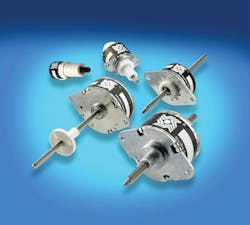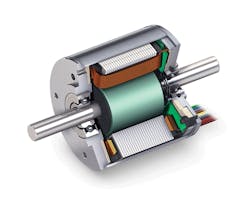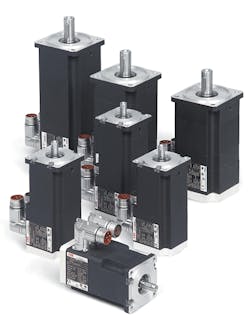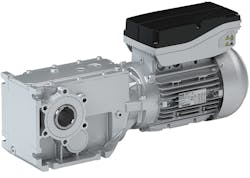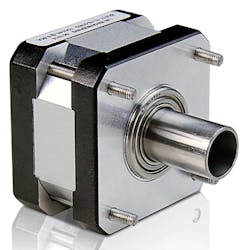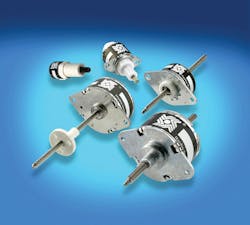A Closer Look at Motors for Motion
Motors play key roles in many motion-control functions across a multitude of industries, from packaging, food and beverage, and manufacturing to medical and robotics. Engineers can choose from several motor types, depending on function, size, torque, accuracy, and speed requirements.
This file type includes high resolution graphics and schematics when applicable.
DC Motors
Direct-current (dc) motors tend to have a low torque unless they are paired with a gearbox. A gearbox will decrease the motor’s speed and increase the torque output. If a dc motor, for example, rotates at 10,000 rpm and produces a torque of 0.001 N-m (0.0089 lbf-in), its torque can be increased by a factor of 300 by attaching a gearbox with a gear down ratio of 300:1. This reduces the rpm to 33.3 rpm and increases the torque to 0.3 N-m (2.66 lbf-in).
A brush dc motor functions with two magnets facing the same direction around a rotor. They surround two coils of wire in the middle of the motor. The coils are positioned facing the magnets, causing electricity to flow. The magnetic field that’s generated pushes the coils away and causes rotor rotation. The carbon brushes, located inside the rotor, conduct current between stationary wires and moving parts. They are attached via rings to the rotor’s shaft, which are connected to an electrical circuit. Rotation speed is proportional to the applied voltage. Brush dc motors, with their simple construction, offer a cost-effective solution.
Maxon Precision Motors added four new sizes to its Maxon X Drive family of brushed dc motors. The three-stage motors are now available in 14-, 16-, 22-, and 26-mm-long diameters. These motors offer high continuous torque and power. They range in rpm from 7,720 to 11,600 rpm and 4.11 to 132 mN-m.
Along with these motors, Maxon introduced new GPX planetary gearheads, which have scaled gear advantages. The drive system is smaller, lighter, and more economical. The gearheads come in 14-, 19-, 26-, and 37-mm diameters. The existing GPX 16 and 32 models are now available with ceramic axles. These will reduce wear and lower gearhead noise.
Brushless dc motors contain no carbon brushes. They have permanent magnet poles on the rotor which are attracted to the opposite magnetic polarity of the rotating poles located on the stator. This creates torque and instead of brushes providing the dc current, an electronic speed controller provides the current. Brushless dc motors require less maintenance, generate less noise, and create less electromagnetic interference (EMI).
EC-i motors from Maxon Motors are suited for automation and robotics. These compact (40-mm diameter) options offer simultaneous high energy and torque, and come in two length sizes. The 26-mm length offers 12,400 rpm with 43.2 mN-m or 13,200 rpm with 52.7 mN-m. The 36-mm length maintains 10,100 rpm with 68.4 mN-m or 10,700 with 82.9 mN-m. They have low inertia of 10.5 g-cm2, are robust, ensure high power density, and offer maximum drive in minimum space requirements.
AC Servo Motors
Alternate-current (ac) motors, which function like brushless motors, target applications that require rapid and accurate response. Their design has small diameters and high resistance rotors, thus providing low inertia for fast starts and stops.
The N-Servo ac brushless servo motors from Baldor provide a design with neodymium-iron-boron magnets. Continuous stall torque ranges from 0.45 to 40 N-m, and acceleration torque from 1.8 to 160 N-m. The servo motors are 200°C moisture-resistant and designed to operate in temperatures up to 155°C. Their inertia range, 0.067 to 38 Kg-cm2, is low to attain high acceleration capability. The servo motors are not only common in robotics, but also medical, packaging, and manufacturing industries.
The Lenze Smart ac motor delivers near-field communications (NFC) for smartphone controllability. It features three digital inputs for changing speed and motor rotation and one digital output for status readings. The easily adjustable speed, which reduces the required number of different drives, can be set between 500 and 2,600 rpm. It has a higher starting torque than continuous torque, as well as being compact and energy-efficient. Max torque ranges from 7 to 20 N-m.
Stepper Motors
Stepper motors achieve mechanical movement through digital pulses instead of continuous voltage. They rotate or step in fixed angular increments. A pulse generator communicates with the stepper driver, which controls speed and positioning. With each control pulse, the stepper motor and driver convert digital information into exact rotational steps.
Lin Engineering released the new Whisper Torque ZH417-11 hollow shaft stepper motor. It is a 0.9°, NEMA 17 stepper motor with an 11-mm inner diameter. Instead of a magnet on the rotor, it has a ring magnet around the stator coils. Without the permanent magnet, large shaft dimensions can be implemented, since only the outer edges of the rotor are used. The motor maintains a holding torque of 0.12 N-m and an inertia of 21.9 g-cm2.
Haydon Kerk offers a family of ac can-stack stepper-motor linear actuators. Stepper-motor linear actuators use the stepping motor for rotary power, but replace the shaft of the rotor with a lead screw. Linear motion occurs as the rotor turns and advances the nut and threaded screw. A small rotation force on the lead screw can translate into a large load capability, depending on the thread lead. A smaller thread lead (or more threads per inch) will provide a higher force, and a large thread lead has a lower force with a higher linear speed. Five basic frame sizes are available: 15, 20, 26, 36, and 46 mm in diameter. They operate with a torque range of 0.4 to 1.8 N-cm; the linear actuator has a force range of 8 to 191 N. The stepping motors are available in 300- or 600-rpm options.
This file type includes high resolution graphics and schematics when applicable.
